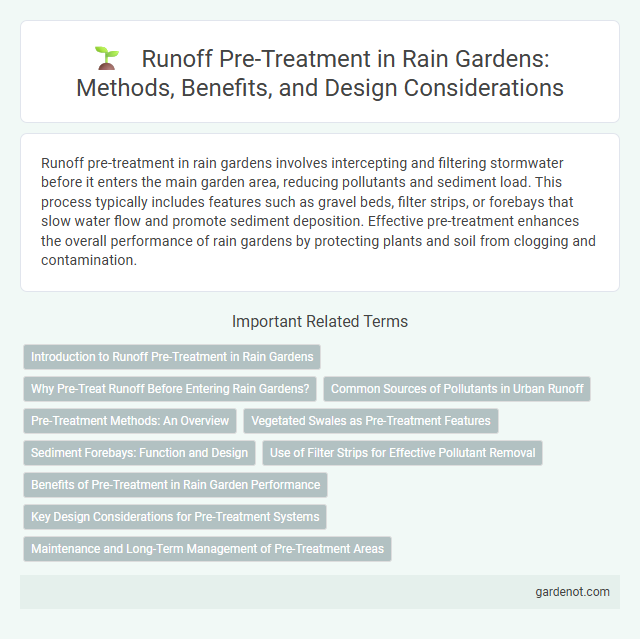Runoff pre-treatment in rain gardens involves intercepting and filtering stormwater before it enters the main garden area, reducing pollutants and sediment load. This process typically includes features such as gravel beds, filter strips, or forebays that slow water flow and promote sediment deposition. Effective pre-treatment enhances the overall performance of rain gardens by protecting plants and soil from clogging and contamination.
Introduction to Runoff Pre-Treatment in Rain Gardens
Runoff pre-treatment in rain gardens involves capturing and filtering stormwater before it enters the main infiltration area, reducing pollutants and sediment load. Common pre-treatment methods include sedimentation forebays, vegetated filter strips, and gravel diaphragms designed to improve water quality and prevent clogging. Effective pre-treatment enhances the longevity and performance of rain gardens by minimizing maintenance and protecting downstream ecosystems.
Why Pre-Treat Runoff Before Entering Rain Gardens?
Pre-treating runoff before it enters rain gardens reduces sediment, debris, and pollutants, preventing clogging and maintaining optimal infiltration rates. This process enhances water quality by capturing contaminants upfront, ensuring healthier plant growth and long-term garden functionality. Effective pre-treatment extends rain garden lifespan and maximizes stormwater management efficiency.
Common Sources of Pollutants in Urban Runoff
Urban runoff commonly carries pollutants such as oils, heavy metals, sediments, and nutrients originating from vehicle emissions, industrial sites, construction areas, and residential landscapes. These contaminants threaten water quality by entering stormwater systems before reaching rain gardens. Implementing pre-treatment methods like sedimentation basins and vegetative filters reduces pollutant loads, enhancing the effectiveness of rain garden filtration.
Pre-Treatment Methods: An Overview
Runoff pre-treatment methods in rain gardens primarily include sedimentation basins, vegetative filter strips, and forebays designed to capture and settle out sediments and pollutants before water enters the main infiltration area. These techniques effectively reduce total suspended solids, nutrients, and hydrocarbons, enhancing the overall filtration efficiency of the rain garden system. Properly designed pre-treatment structures minimize clogging and extend the functional lifespan of rain gardens by ensuring cleaner runoff infiltration.
Vegetated Swales as Pre-Treatment Features
Vegetated swales serve as effective pre-treatment features for runoff by slowing water flow and promoting sedimentation before it reaches a rain garden. Their dense plant roots and soil matrix filter pollutants such as heavy metals, nutrients, and sediments, enhancing water quality. Integrating vegetated swales into stormwater management systems reduces erosion and protects downstream aquatic ecosystems.
Sediment Forebays: Function and Design
Sediment forebays in rain garden runoff pre-treatment serve as primary settling zones, capturing coarse sediments and debris to prevent clogging and extend the garden's lifespan. Designed with sufficient volume and accessible for periodic maintenance, forebays are typically incorporated at the inflow points, allowing heavy particles to settle before water enters the main treatment area. Proper sizing based on watershed area and sediment load ensures effective sediment removal, reducing turbidity and enhancing overall stormwater quality in rain garden systems.
Use of Filter Strips for Effective Pollutant Removal
Filter strips serve as a crucial pre-treatment method in rain garden runoff management by slowing water flow and enhancing pollutant filtration through vegetation and soil. These strips effectively reduce sediment, nutrients, and heavy metals before water enters the rain garden, improving overall water quality. Proper design and plant selection in filter strips maximize their pollutant removal efficiency and prevent clogging or erosion.
Benefits of Pre-Treatment in Rain Garden Performance
Runoff pre-treatment in rain gardens enhances water quality by filtering out sediments, nutrients, and pollutants before entering the infiltration zone. This process reduces clogging and extends the lifespan of the rain garden system while improving groundwater recharge efficiency. Effective pre-treatment supports healthier ecosystems by decreasing contaminants and promoting cleaner stormwater management.
Key Design Considerations for Pre-Treatment Systems
Effective runoff pre-treatment in rain gardens involves selecting sediment forebays or filter strips to capture pollutants and coarse sediments before water reaches the planting area. Design considerations include sizing pre-treatment structures to handle peak flow rates, ensuring easy access for maintenance, and using vegetation or engineered media to promote pollutant removal. Properly integrated pre-treatment systems reduce clogging, improve infiltration rates, and enhance overall stormwater management performance.
Maintenance and Long-Term Management of Pre-Treatment Areas
Proper maintenance of runoff pre-treatment areas in rain gardens is essential to prevent clogging and ensure effective filtration of sediments and pollutants. Regular removal of accumulated debris, sediment, and invasive vegetation supports optimal water flow and enhances the longevity of biofiltration media. Implementing routine inspections and adaptive management strategies addresses wear and sustains the rain garden's capacity to improve urban stormwater quality over time.
Runoff pre-treatment Infographic

 gardenot.com
gardenot.com